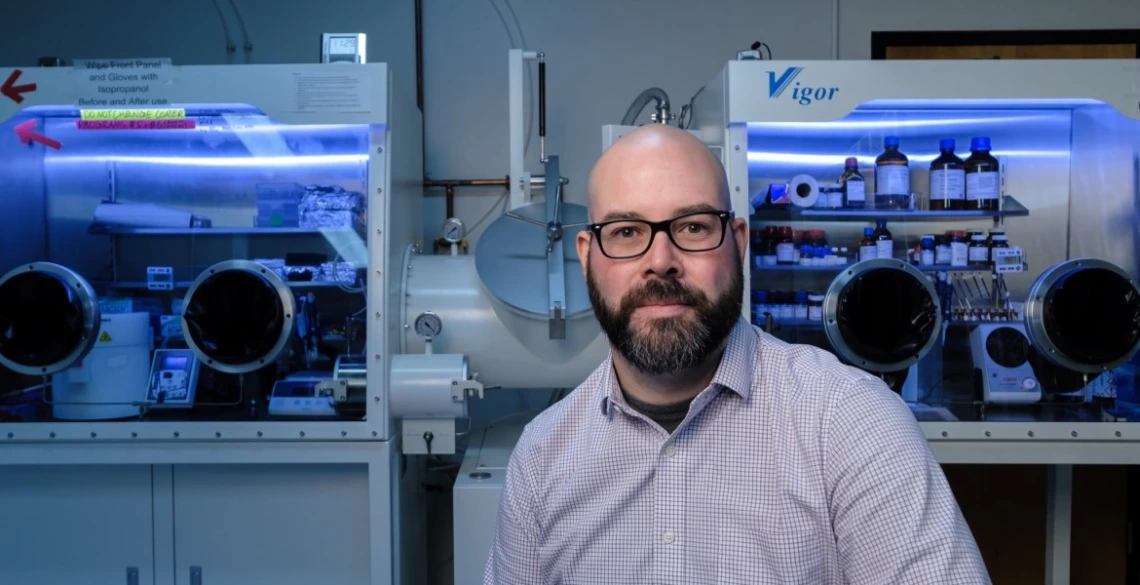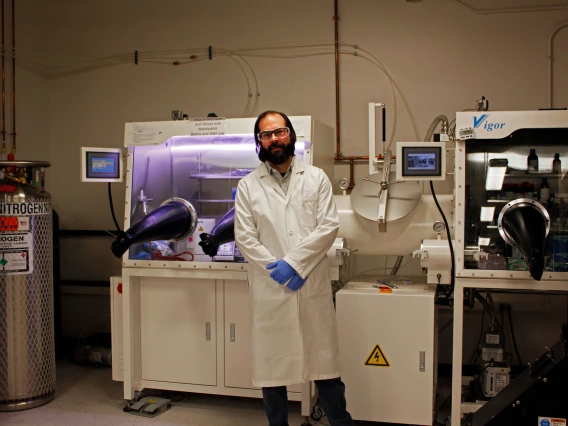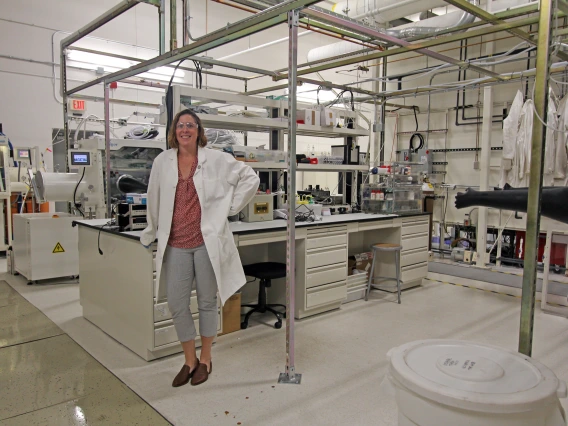NSF CAREER Awardee Advances Lightweight, Low-Cost Solar Technology
Perovskite photovoltaics are a promising method for generating solar energy, but molecular-level instabilities have prevented their widespread use. With a prestigious National Science Foundation Award, an engineering professor seeks to deepen...

Chemical and environmental engineering assistant professor Adam Printz is the recipient of a 2023 CAREER Award from the National Science Foundation.
Solar energy is set to play a key role in the United States reaching its goal of a net zero emissions economy by 2050. In addition to conventional solar panels, which are made predominately of silicon and cadmium telluride, perovskite photovoltaics are likely to be part of the solution.
“Perovskite-based photovoltaics are exciting because they can be printed like newspapers and only require a small fraction of the material used in traditional photovoltaic technologies,” said chemical and environmental engineering assistant professor Adam Printz. “Less material usage reduces costs and waste, meaning that long-term, perovskite-based photovoltaics are an attractive replacement for current technologies.”
Perovskites are ultrathin – only a few hundred nanometers thick, or about around 1% the width of a human hair – and can be printed on flexible plastic substrates, which means they could be used in applications where portability and weight are key design factors including disaster relief, aviation, space exploration, and portable sensors for health care. However, perovskite photovoltaics aren’t yet commercially viable because they still exhibit chemical and mechanical instabilities, which cause them to degrade and stop working more quickly than other technologies. What exactly causes these instabilities, and how can they be mitigated to improve perovskite performance?
With a $500,000 CAREER Award from the National Science Foundation, Printz intends to figure it out. In tandem, he’s working to launch a video series and a renewable energy minor to educate a new generation of scientists.
Understanding Why and Where Defects Form
The word “perovskite” originally referred to a mineral, first discovered in the early 19th century, with the crystal structure ABX3. Nowadays, the word is also used as shorthand to refer to “metal halide perovskite-based photovoltaics,” or lab-made materials that have an ABX3 crystal structure and offer properties like photoconductivity and the ability to be made into inks.
In the ABX3 crystal structure, the A is a cation or positively charged ion, the B is a metal (typically lead or tin), and the X is a halide (a type of atom that functions as an anion, or negatively charged ion). All of these are dissolved into a solvent to make an ink, which can be printed onto a flexible plastic substrate, similar to how ink is printed onto a newspaper. The resulting film is heated up so the solvent evaporates and the perovskite can crystallize.
As the film cools down, the perovskite is naturally inclined to shrink more than the substrate material. However, since the film and substrate are attached, the perovskite shrinks less in the areas where it’s touching the substrate. Think of how the center of a tennis net sags slightly, because it’s closer to being at rest, but on the sides, it sits higher, because it’s held up by poles. The difference between the perovskite’s natural lattice pattern (like the middle of a tennis net) and the pattern in direct contact with the substrate (like the sides of a tennis net) causes strain, forming a lattice strain gradient.
“We know that lattice strain is problematic, and it likely creates instabilities,” Printz said. “We also know that there is a vertical strain gradient in these films, meaning the amount of strain is different at the top of the film than at the bottom of the film. So far, nobody has really tied these strain gradients to stability, nor how these gradients result in different defect densities throughout the perovskite films.”
Eliminating Defects and Modulating Strain
One known way to mitigate these defects, even though their behaviors are not fully understood, is to incorporate organic materials called additives into the perovskite films.
“Additives basically address defects and remove them from the equation,” Printz said. “We’re going to try to use these additives not just to attack defects, but also to allow the strain to be modulated in the perovskite material, so we can potentially pull the atoms apart or push them together and get different properties and stability.”
However, because perovskites consist of three categories of ingredients, and each category has an array of options, there are a huge and ever-growing number of perovskite formations. So, even if a team of scientists found an additive that eliminated defects using a particular perovskite formula, the formula will likely soon be obsolete as better versions are developed. Then the search for the right additive would start again.
Printz and his team are starting off by testing different additives on a very simple perovskite formulation, then testing the same group of additives on more chemically complex perovskites.
From there, they plan to use a combination of experiments, simulations, and eventually machine learning to begin developing a database documenting which additives work with which perovskite formulations.
“A person might be able to input into the database, ‘This is the perovskite formulation I’m working with,’ and the database might say, ‘Try these three additives,’ or ‘Try these 17 additives,’” Printz said. “We’re taking a very systematic approach.”
The ability to control the strain and defect density could be useful beyond the world of perovskites, in applications ranging from transistors to physics experiments.
‘Scientists Like Me’ Video Series
Printz’s CAREER project also includes several student-focused elements, in collaboration with programs like Arizona Science, Engineering and Math Scholars. First, he and his team plan to launch a series of seminars to help marginalized students develop research readiness. In tandem, they will create a series of videos called “Scientists Like Me,” in which scientists from a range of backgrounds will speak about scientific and societal topics.
“With this format, we intend to both humanize the scientists and inspire students, allowing them to envision themselves as future scientists,” Printz said.



